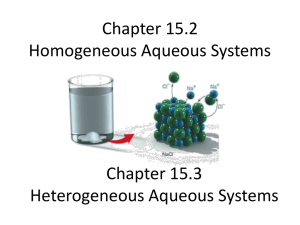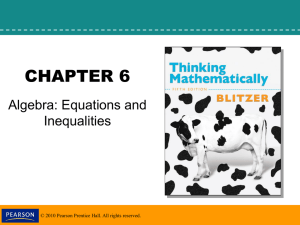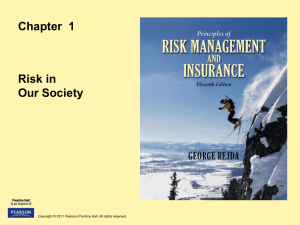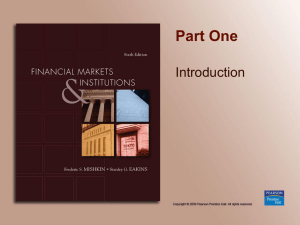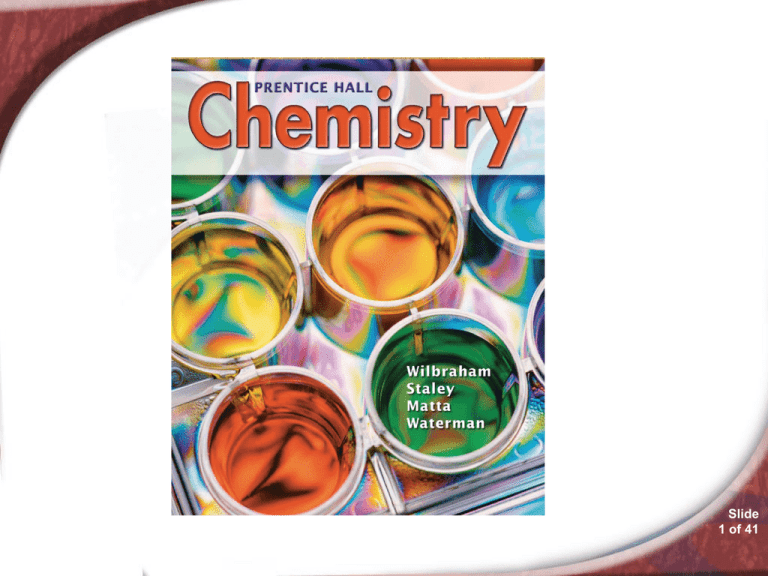
15.2 Chemistry
Slide
1 of 41
15.2
Homogeneous Aqueous Systems
An ordinary dill pickle from
the deli can be a source of
light! Iron or copper
electrodes are inserted
into the ends of the pickle
and connected to a source
of alternating electric
current. You will learn what
kind of solution conducts
electricity.
© Copyright Pearson Prentice Hall
Slide
2 of 41
15.2
Homogeneous
Aqueous Systems
>
Solvents and Solutes
Solvents and Solutes
What is the difference between a solvent
and a solute?
Slide
3 of 41
© Copyright Pearson Prentice Hall
15.2
Homogeneous
Aqueous Systems
>
Solvents and Solutes
• An aqueous solution is water that contains
dissolved substances.
• In a solution, the dissolving medium is the
solvent.
• In a solution, the dissolved particles are the
solute.
Slide
4 of 41
© Copyright Pearson Prentice Hall
15.2
Homogeneous
Aqueous Systems
>
Solvents and Solutes
A solvent dissolves the solute. The
solute becomes dispersed in the solvent.
• Solvents and solutes may be gases,
liquids, or solids.
• Solute particles can be atoms, ions, or
molecules.
Slide
5 of 41
© Copyright Pearson Prentice Hall
15.2
Homogeneous
Aqueous Systems
>
Solvents and Solutes
If you filter a solution through filter paper, both
the solute and the solvent pass through the filter.
Slide
6 of 41
© Copyright Pearson Prentice Hall
15.2
Homogeneous
Aqueous Systems
>
The Solution Process
The Solution Process
What happens in the solution process?
Slide
7 of 41
© Copyright Pearson Prentice Hall
15.2
Homogeneous
Aqueous Systems
>
The Solution Process
As individual solute ions break away
from the crystal, the negatively and
positively charged ions become
surrounded by solvent molecules, and
the ionic crystal dissolves.
Slide
8 of 41
© Copyright Pearson Prentice Hall
15.2
Homogeneous
Aqueous Systems
>
The Solution Process
The process by which the positive and negative
ions of an ionic solid become surrounded by
solvent molecules is called solvation.
Slide
9 of 41
© Copyright Pearson Prentice Hall
15.2
Homogeneous
Aqueous Systems
>
The Solution Process
Solvation of an Ionic Solid
Slide
10 of 41
© Copyright Pearson Prentice Hall
15.2
Homogeneous
Aqueous Systems
>
The Solution Process
• Polar solvents such as water dissolve ionic
compounds and polar compounds.
• Nonpolar solvents such as gasoline dissolve
nonpolar compounds.
Slide
11 of 41
© Copyright Pearson Prentice Hall
15.2
Homogeneous
Aqueous Systems
>
The Solution Process
Oil and water do not mix.
Slide
12 of 41
© Copyright Pearson Prentice Hall
Homogeneous
Aqueous Systems
>
The Solution Process
Simulation 18 Explore the nature of solutesolvent interactions.
Slide
13 of 41
© Copyright Pearson Prentice Hall
15.2
Homogeneous
Aqueous Systems
>
Electrolytes and Nonelectrolytes
Electrolytes and Nonelectrolytes
Why are all ionic compounds
electrolytes?
Slide
14 of 41
© Copyright Pearson Prentice Hall
15.2
Homogeneous
Aqueous Systems
>
Electrolytes and Nonelectrolytes
An electrolyte is a compound that conducts an
electric current when it is in an aqueous solution
or in the molten state.
All ionic compounds are electrolytes
because they dissociate into ions.
Slide
15 of 41
© Copyright Pearson Prentice Hall
15.2
Homogeneous
Aqueous Systems
>
Electrolytes and Nonelectrolytes
The bright glow shows
that sodium chloride is a
strong electrolyte
because nearly all the
dissolved sodium
chloride exists as
separate Na+ and Cl–
ions.
Slide
16 of 41
© Copyright Pearson Prentice Hall
15.2
Homogeneous
Aqueous Systems
>
Electrolytes and Nonelectrolytes
A weak electrolyte
conducts electricity
poorly because only a
fraction of the solute in
the solution exists as
ions.
Slide
17 of 41
© Copyright Pearson Prentice Hall
15.2
Homogeneous
Aqueous Systems
>
Electrolytes and Nonelectrolytes
A compound that does
not conduct an electric
current in either aqueous
solution or the molten
state is called a
nonelectrolyte.
Slide
18 of 41
© Copyright Pearson Prentice Hall
Homogeneous
Aqueous Systems
>
Electrolytes and Nonelectrolytes
Simulation 19 Simulate the behavior of
electrolytes and nonelectrolytes in a circuit
and at the atomic level.
Slide
19 of 41
© Copyright Pearson Prentice Hall
15.2
Homogeneous
Aqueous Systems
>
Hydrates
Hydrates
How do you write the formula for a
hydrate?
Slide
20 of 41
© Copyright Pearson Prentice Hall
15.2
Homogeneous
Aqueous Systems
>
Hydrates
A compound that contains water of hydration is
called a hydrate.
In writing the formula of a hydrate, use
a dot to connect the formula of the
compound and the number of water
molecules per formula unit.
Slide
21 of 41
© Copyright Pearson Prentice Hall
15.2
Homogeneous
Aqueous Systems
>
Hydrates
A sample of blue CuSO4·5H2O is heated.
Slide
22 of 41
© Copyright Pearson Prentice Hall
15.2
Homogeneous
Aqueous Systems
>
Hydrates
Blue crystals of CuSO4·5H2O crumble to a white
anhydrous powder that has the formula CuSO4.
Slide
23 of 41
© Copyright Pearson Prentice Hall
15.2
Homogeneous
Aqueous Systems
>
Hydrates
When treated paper is exposed to moist air, it
turns pink because of the formation of the
hydrate cobalt(II) chloride hexahydrate
(CoCl2·6H2O).
Slide
24 of 41
© Copyright Pearson Prentice Hall
15.2
Homogeneous
Aqueous Systems
>
Hydrates
Slide
25 of 41
© Copyright Pearson Prentice Hall
15.2
Homogeneous
Aqueous Systems
>
Hydrates
Efflorescent Hydrates
If a hydrate has a vapor pressure higher than the
pressure of water vapor in the air, the hydrate
will lose its water of hydration, or effloresce.
Slide
26 of 41
© Copyright Pearson Prentice Hall
15.2
Homogeneous
Aqueous Systems
>
Hydrates
Hygroscopic Hydrates
Hydrated salts that have a low vapor pressure
remove water from moist air to form higher
hydrates. These hydrates and other compounds
that remove moisture from air are called
hygroscopic.
Slide
27 of 41
© Copyright Pearson Prentice Hall
15.2
Homogeneous
Aqueous Systems
>
Hydrates
To determine what percent of a hydrate is water,
first determine the mass of the number of moles
of water in one mole of hydrate. Then determine
the total mass of the hydrate. The percent by
mass of water can be calculated using this
equation.
Slide
28 of 41
© Copyright Pearson Prentice Hall
SAMPLE PROBLEM 15.1
Sample
Problem 15.1
15.1
Slide
29 of 41
© Copyright Pearson Prentice Hall
SAMPLE PROBLEM 15.1
Sample Problem 15.1
Slide
30 of 41
© Copyright Pearson Prentice Hall
SAMPLE PROBLEM 15.1
Sample Problem 15.1
Slide
31 of 41
© Copyright Pearson Prentice Hall
SAMPLE PROBLEM 15.1
Sample Problem 15.1
Slide
32 of 41
© Copyright Pearson Prentice Hall
Practice Problems for Sample Problem 15.1
Practice Problem For Sample Problem 15.1
Problem Solving 15.6 Solve
Problem 6 with the help of an
interactive guided tutorial.
Slide
33 of 41
© Copyright Pearson Prentice Hall
15.2
Homogeneous
Aqueous Systems
>
Hydrates
Deliquescent Compounds
Deliquescent compounds remove sufficient
water from the air to dissolve completely and
form solutions. These compounds become wet
when exposed to normally moist air.
Slide
34 of 41
© Copyright Pearson Prentice Hall
15.2
Homogeneous
Aqueous Systems
>
Hydrates
The deliquescent substance, sodium hydroxide,
absorbs moisture from air.
Slide
35 of 41
© Copyright Pearson Prentice Hall
15.2
Homogeneous
Aqueous Systems
>
Hydrates
A solution forms.
Slide
36 of 41
© Copyright Pearson Prentice Hall
15.2 Section Quiz.
Assess students’ understanding
of the concepts in Section 15.2.
Continue to:
-or-
Launch:
Section Quiz
Slide
37 of 41
© Copyright Pearson Prentice Hall
15.2 Section Quiz.
1. Choose the correct words for the spaces. In
any solution, the material that is dissolved is
called the _______ and the material in which
the substance is dissolved is called the
_______ .
a. solid, liquid
b. solvent, solute
c. solute, solvent
d. crystal, disperser
© Copyright Pearson Prentice Hall
Slide
38 of 41
15.2 Section Quiz.
2. In the solution process, the
a. solvent molecules are surrounded by
positive and negative ions.
b. solvent molecules become dispersed in an
ionic crystal.
c. ions become emulsified in the solvent.
d. positive and negative ions are surrounded
by solvent molecules.
Slide
39 of 41
© Copyright Pearson Prentice Hall
15.2 Section Quiz.
3. All ionic compounds are electrolytes because
they
a. conduct electricity in the solid state.
b. dissociate into ions in the aqueous and/or
the molten state.
c. remain as positive-negative pairs even
when dissolved.
d. only conduct electricity in the molten state.
Slide
40 of 41
© Copyright Pearson Prentice Hall
15.2 Section Quiz.
4. The formula for iron(II) sulfate heptahydrate is
a. FeSO4(H2O)7
b. FeSO4•(H2O)7
c. Fe•2SO4•7H2O
d. FeSO4•7H2O
Slide
41 of 41
© Copyright Pearson Prentice Hall
END OF SHOW



